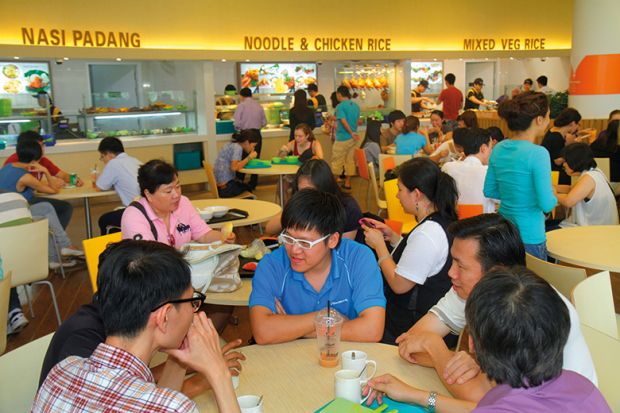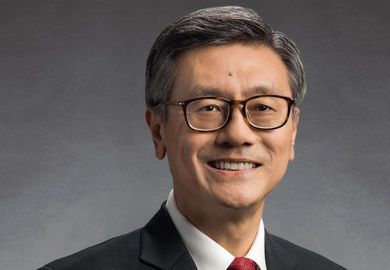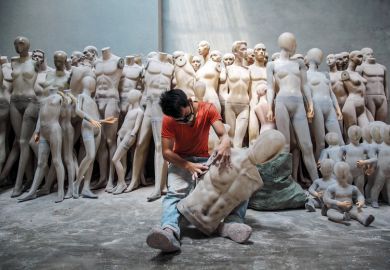University canteens do not normally inspire awe and wonder, but the National University of Singapore’s dining halls are a bit different.
Visitors to the 700-seater Flavours food court can choose their reasonably priced meals from more than a dozen separate outlets, each offering a different type of cuisine from Southeast Asia, including Thai, Indonesian, Malaysian, Korean and Japanese. It is not even the biggest dining area either: a further three 850-plus seater canteens and numerous smaller restaurants and cafes are dotted around the university’s modernist campus. In total, they feed about 50,000 people each day, serving a meal every 1.4 seconds on average.
“Eating out is a big thing in Singapore, which is why we’ve invested a lot of money in our dining halls,” explained Tan Chorh Chuan, who stepped down as the university’s president last month after nine years in charge. On his watch, the National University of Singapore (NUS) overtook the University of Tokyo in 2015 as Asia’s top-ranked university in Times Higher Education’s World University Rankings and cemented its pole position this year, finishing 22nd overall, up from 40th in 2012.
While the incredible variety of dining options on campus might seem incidental to this success, Professor Tan believes that it has played an important role in the university’s improvement on his watch.
“These are not just places where you eat – it’s where students and staff linger, mix and also learn from each other,” he said, adding that this element of campus life is “a cultural dimension that makes Singapore special”.
In an interview with THE in London, where he gave the Higher Education Policy Institute’s annual lecture last month, Professor Tan explained how the completion in 2011 of the University Town complex, where many of the campus restaurants, as well as its four residential colleges, learning spaces and open-air communal areas are based, had been a “real milestone” of his tenure because it had significantly reshaped life on campus.
“It allowed us to redesign – almost from scratch – the entire campus around a new academic vision, which included [introducing] experiential learning and bringing together diverse groups of people,” he said.
The multimillion-dollar “UTown” is one of several major projects overseen by Professor Tan; most recently, the university opened its £148-million Yale-NUS College in 2015, a unique partnership with the Ivy League university, while the Duke-NUS Medical School that opened in 2007 has continued to thrive.
Managing these partnerships – alongside running a university with 38,000 students and a S$2.6 billion (£1.5 billion) annual budget – had been one of Professor Tan’s trickiest tasks while in office, he admitted.
“When you go into partnership with Duke and Yale, you are creating completely new schools with partners on the other side of the world,” he explained. “We also wanted to co-create new forms of education and this is an inherently risky thing.”
Nonetheless, many vice-chancellors might probably feel that they could achieve similar levels of success given the vast resources put at Professor Tan’s disposal in recent years. In September, for instance, NUS’ student paper The Bullet complained that the university’s Lee Kong Chian Natural History Museum had spent S$8 million (£4.4 million) on acquiring the bones of three three diplodocid sauropod dinosaurs.
Has Professor Tan’s job been relatively easy given the spending power granted to him by Singapore’s highly education and research-friendly government?
“We have had a government which gives us a lot of autonomy and continued long-term support, but the university has not tried to improve incrementally – it has tried to be bold and innovate,” he countered.
“There has always been aspiration at NUS, but the ideas for change [over the past decade] have been much broader, forcing faculty members across all our schools to do new things,” he added.
To become one of the world’s top universities, huge spending alone would not cut it, insisted Professor Tan, saying that he believed NUS’ “aspiration for excellence” had been transformed.
“When you are driven by aspiration to compete at a global level, [you have] to innovate in education and research. You need to develop your talent and also recruit from overseas and all this takes a lot of effort,” he said.
Register to continue
Why register?
- Registration is free and only takes a moment
- Once registered, you can read 3 articles a month
- Sign up for our newsletter
Subscribe
Or subscribe for unlimited access to:
- Unlimited access to news, views, insights & reviews
- Digital editions
- Digital access to THE’s university and college rankings analysis
Already registered or a current subscriber?









